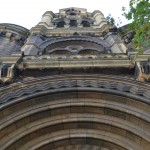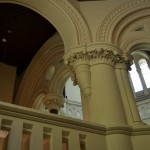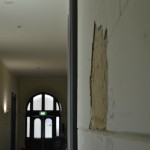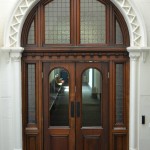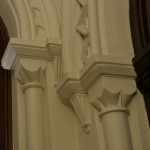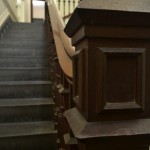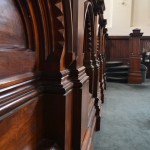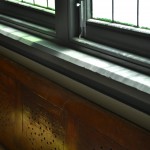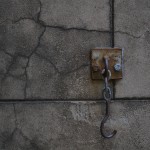I visited Building 20, the former Magistrates Court, in the morning, early afternoon, and late afternoon/ evening. Initially I struggled to find the entrance, as most of the doors were no longer in use. For this reason, the building was very quiet. Although there were old doors littered around the building, nobody was using them, thus, most of the halls and old entrance ways were peaceful. Immediately I felt a sense of stillness. Because of this, the building was a comfortable space. A space one would feel at ease wandering around in their own time, taking it in slowly, as I did. There were a few people working inside, but nothing felt rushed. The commotion just outside for the university’s club sign up day was not at all audible. The thick stone walls no doubt insulating the space from the noise.
Some areas, such as the old courtrooms and the old entrance on the corner of Russell and Latrobe street were awe inspiring. The architecture was stylised and ornate, seemingly unchanged from when the court was first built one hundred years ago. I felt a sense of wonderment and grandeur.
Some areas, however, were uncomfortable. I didn’t see any other students in the building, but I did find a number of staff working in their offices with their doors open. The quietness of the space made me uncomfortable here, as I felt as though I wasn’t supposed to be there; that perhaps I was disturbing some important work being done. The building feels grand and important, and as I encountered people I kept thinking they were going to ask me to leave, I felt like an imposing tourist. Many people did ask me whether I was lost, so in that sense, the building was a little uncomfortable because it is so closed off to the public, in both design and use.
During the evening the space wasn’t creepy or scary, but it felt distinctly different than it did during the day. The whole building has large windows in all of the rooms, so in the early afternoon the area was bathed in light and warmth. Once it was later in the day, many people had gone home and the sky was darker, but the character of the building was still inviting. The stillness of the atmosphere was accentuated at this time, and the space felt much lonelier.
The most interesting parts of the building were the remnants of its history. The exterior was intriguing for this reason because it seemed largely unchanged and unrenovated since the building was opened. The architecture was certainly not modern, and along the driveway beside the building, there were large cracks and rusted over metal features. This is what made the area charming. It was overtly aged, but not decrepit. There was a sense of history, but the architecture was still beautiful and impressive.
Some areas inside were also captivating, such as the extraordinary dome in the old entrance way. These features were echoed throughout the entire building, with unique plaster trims decorating around the archways of the doors. This entrance area was full of stylised buttresses and archways. The plaster also contrasted with the wooden ceilings, which were also found in the courtrooms. These architectural features are rarely seen today in modern buildings, so it was fascinating to see them on such a grand scale.
Another interesting part of the space was in the courtroom. Large paintings of important figures were positioned around the room. I would be interested to explore these specific people more, as this is another insight into the spaces use in history.
It was immediately obvious the elements of technology that had been introduced in the building over time. The bright green exit signs above almost every doorway contrasted heavily with the classic features of the architecture. As I was exploring the courtroom, a staff member was setting up a projector screen with a slideshow on the wall. The projection seemed out of place on the old wall, and I found it interesting to see how the space was being used today. As well as being a heritage site, these old rooms are still being used and new elements are being brought into the space to suit the needs of its new users.
The space has a long, important history as a part of Melbourne. Initially being the location of the supreme court, and then afterwards, the magistrates court was built and opened in the space in 1914. Since then, the building has been made a part of RMIT and the judicial precinct that surrounded it has dispersed.
More about the area’s history:
Dalton, Simon. The Old Melbourne City Watch House: Fast-forward to the Past [online]. Agora, Vol. 43, No. 4, 2008: 60-62. <http://search.informit.com.au.ezproxy.lib.rmit.edu.au/documentSummary;dn=490096764027465;res=IELAPA> ISSN: 0044-6726.
Reynolds, Sue. The old Supreme Court of Victoria buildings: everything old is new again. [online]. Victorian Historical Journal, Vol. 81, No. 2, Nov 2010: 233-249. <http://search.informit.com.au.ezproxy.lib.rmit.edu.au/documentSummary;dn=201211775;res=IELAPA> ISSN: 1030-7710.
(For images, refer to Google Doc for copyright reasons: https://drive.google.com/a/rmit.edu.au/folderview?id=0ByoK-Gqhdx9EMHRQSUh2Vm9fVE0&usp=sharing)
“Opening of the City Court, Melbourne, on 20th January, 1914.”
“[Melbourne Magistrates Court and Russell Street Police Headquarters from La Trobe Street] [picture”
“Old Supreme Court c/r of La Trobe and Russell Sts. built in 1842 on the present site of the City Court, Melbourne[picture] ”

